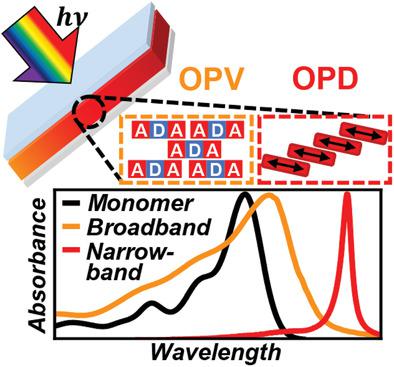当前位置:
X-MOL 学术
›
Adv. Mater.
›
论文详情
Our official English website, www.x-mol.net, welcomes your
feedback! (Note: you will need to create a separate account there.)
Slip-Stacked J-Aggregate Materials for Organic Solar Cells and Photodetectors
Advanced Materials ( IF 27.4 ) Pub Date : 2021-10-19 , DOI: 10.1002/adma.202104678 Jin Hong Kim 1 , Tim Schembri 1 , David Bialas 2 , Matthias Stolte 1, 2 , Frank Würthner 1, 2
Advanced Materials ( IF 27.4 ) Pub Date : 2021-10-19 , DOI: 10.1002/adma.202104678 Jin Hong Kim 1 , Tim Schembri 1 , David Bialas 2 , Matthias Stolte 1, 2 , Frank Würthner 1, 2
Affiliation

|
Dye–dye interactions affect the optical and electronic properties in organic semiconductor films of light harvesting and detecting optoelectronic applications. This review elaborates how to tailor these properties of organic semiconductors for organic solar cells (OSCs) and organic photodiodes (OPDs). While these devices rely on similar materials, the demands for their optical properties are rather different, the former requiring a broad absorption spectrum spanning from the UV over visible up to the near-infrared region and the latter an ultra-narrow absorption spectrum at a specific, targeted wavelength. In order to design organic semiconductors satisfying these demands, fundamental insights on the relationship of optical properties are provided depending on molecular packing arrangement and the resultant electronic coupling thereof. Based on recent advancements in the theoretical understanding of intermolecular interactions between slip-stacked dyes, distinguishing classical J-aggregates with predominant long-range Coulomb coupling from charge transfer (CT)-mediated or -coupled J-aggregates, whose red-shifts are primarily governed by short-range orbital interactions, is suggested. Within this framework, the relationship between aggregate structure and functional properties of representative classes of dye aggregates is analyzed for the most advanced OSCs and wavelength-selective OPDs, providing important insights into the rational design of thin-film optoelectronic materials.
中文翻译:

用于有机太阳能电池和光电探测器的滑动堆叠 J 型骨料
染料-染料相互作用影响光收集和检测光电应用的有机半导体薄膜的光学和电子特性。本综述详细阐述了如何为有机太阳能电池 (OSC) 和有机光电二极管 (OPD) 定制有机半导体的这些特性。虽然这些设备依赖于类似的材料,但对它们的光学特性的要求却大不相同,前者需要从紫外到可见光到近红外区域的宽吸收光谱,而后者需要在特定条件下的超窄吸收光谱。 ,目标波长。为了设计满足这些要求的有机半导体,根据分子堆积排列和由此产生的电子耦合,提供了关于光学性质关系的基本见解。基于对滑动堆叠染料之间分子间相互作用的理论理解的最新进展,将具有主要长程库仑耦合的经典 J 聚集体与电荷转移 (CT) 介导或耦合的 J 聚集体区分开来,其红移主要是建议由短程轨道相互作用控制。在此框架内,针对最先进的 OSC 和波长选择性 OPD,分析了代表性染料聚集体的聚集结构和功能特性之间的关系,为薄膜光电材料的合理设计提供了重要见解。建议将具有主要长程库仑耦合的经典 J 聚集体与电荷转移 (CT) 介导或耦合的 J 聚集体区分开来,后者的红移主要受短程轨道相互作用控制。在此框架内,针对最先进的 OSC 和波长选择性 OPD,分析了代表性染料聚集体的聚集结构和功能特性之间的关系,为薄膜光电材料的合理设计提供了重要见解。建议将具有主要长程库仑耦合的经典 J 聚集体与电荷转移 (CT) 介导或耦合的 J 聚集体区分开来,后者的红移主要受短程轨道相互作用控制。在此框架内,针对最先进的 OSC 和波长选择性 OPD,分析了代表性染料聚集体的聚集结构和功能特性之间的关系,为薄膜光电材料的合理设计提供了重要见解。
更新日期:2021-10-19
中文翻译:

用于有机太阳能电池和光电探测器的滑动堆叠 J 型骨料
染料-染料相互作用影响光收集和检测光电应用的有机半导体薄膜的光学和电子特性。本综述详细阐述了如何为有机太阳能电池 (OSC) 和有机光电二极管 (OPD) 定制有机半导体的这些特性。虽然这些设备依赖于类似的材料,但对它们的光学特性的要求却大不相同,前者需要从紫外到可见光到近红外区域的宽吸收光谱,而后者需要在特定条件下的超窄吸收光谱。 ,目标波长。为了设计满足这些要求的有机半导体,根据分子堆积排列和由此产生的电子耦合,提供了关于光学性质关系的基本见解。基于对滑动堆叠染料之间分子间相互作用的理论理解的最新进展,将具有主要长程库仑耦合的经典 J 聚集体与电荷转移 (CT) 介导或耦合的 J 聚集体区分开来,其红移主要是建议由短程轨道相互作用控制。在此框架内,针对最先进的 OSC 和波长选择性 OPD,分析了代表性染料聚集体的聚集结构和功能特性之间的关系,为薄膜光电材料的合理设计提供了重要见解。建议将具有主要长程库仑耦合的经典 J 聚集体与电荷转移 (CT) 介导或耦合的 J 聚集体区分开来,后者的红移主要受短程轨道相互作用控制。在此框架内,针对最先进的 OSC 和波长选择性 OPD,分析了代表性染料聚集体的聚集结构和功能特性之间的关系,为薄膜光电材料的合理设计提供了重要见解。建议将具有主要长程库仑耦合的经典 J 聚集体与电荷转移 (CT) 介导或耦合的 J 聚集体区分开来,后者的红移主要受短程轨道相互作用控制。在此框架内,针对最先进的 OSC 和波长选择性 OPD,分析了代表性染料聚集体的聚集结构和功能特性之间的关系,为薄膜光电材料的合理设计提供了重要见解。











































 京公网安备 11010802027423号
京公网安备 11010802027423号